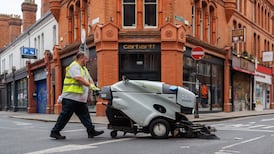June 13th, 1798: Armagh republican Father James Coigly, the co-accused of Arthur O'Connor, is hanged for treason in England on June 7th at Pennenden Heath (Kent). His earlier organisational work in Magilligan, Maghera, Randalstown and many other parts of the North, however, lays the groundwork for the rising which occurs on the day he ascends the gallows.
Henry Joy McCracken, having pressurised Antrim's adjutant-general, Robert Simms, into authorising a turnout, replaces him as leader of Ulster forces. About 8,000 rebels mass on Donegore Hill, from where Antrim town is attacked on the 7th. The crown forces resist weakly when partially overrun but regain the initiative as reinforcements arrive. Lord O'Neil is isolated and piked in the confusion and James Hope's "spartan band" covers the chaotic insurgent retreat towards Ballymena. In nearby Randalstown the "first explosion" traps 70 yeomen in the markethouse. They surrender when the building is fired but the demoralising general picture sparks the dispersal of the Antrim men. The spectre of fuller rebel mobilisation haunts loyalists, and on the 8th Downshire is informed that the "croppies . . are not idle, though there is no rising - 300 of them had a talk near Lurgan in Armagh".
Attention in Dublin is focused on Wicklow's port town of Arklow, where the immediate threat of an insurgent breakout from Wexford is nullified on the 9th. For five hours Maj-Gen Needham's 1,400 strong garrison ply the huge rebel army with musketry and ordnance at point-blank range. Dublin Gazette claims "they advanced in an irregular manner and extended themselves for the purpose of turning" the left flank. Three pike charges are made by Wicklow's "Ballymanus Division" under William Byrne and Anthony Perry's battle-hardened Wexfordians on the lines of the Durham and Dunbartonshire fencibles. An orderly retreat to Gorey Hill commences when Father Michael Murphy is killed and their munitions are expended during the final effort. They leave 1,000 bloodied and dismembered comrades on the field unaware that their enemies have a mere eight rounds of ammunition per man, about two minutes' worth, and "not a canister of grapeshot".
Command of Down's rebels devolves on Henry Munro owing to the arrest of the designated leader, the Rev William Steel Dickson, on the 5th. Munro, a Freemason known to James McKey as "a little hot-headed fellow who kept a shop in Lisburn and bought brown linen", joins the camp at Saintfield on the 10th where Col Stapylton's 270 York fencibles were heavily defeated the previous day. They move to Ednavady Hill, Ballynahinch, where they are confronted by Nugent's columns converging from Downpatrick and Belfast on the 12th. Cannon fire from Windmill Hill pounds rebelheld Ballynahinch and its environs and sporadic fighting continues throughout the night. At length the Down men give way and are harried on the 13th by the 22nd Dragoons and Hillsborough cavalry: 300 rebels fall during the battle and 200 more in the rout phase. McKey comments: "for some years past there was something brooding in the minds of the Republicans, and now it has broke out, and that they could not succeed, they will become loyal subjects".
Camden is less assured and informs Pelham that "unless Great Britain pours an immense force into Ireland the country is lost. Unless she sends her most able generals those troops may be sacrificed. The organisation of this treason is universal, and the formidable numbers in which the rebels assemble oblige all those who have not the good fortune to escape to join them."










